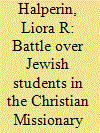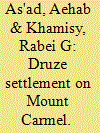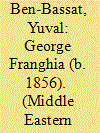|
|
|
Sort Order |
|
|
|
Items / Page
|
|
|
|
|
|
|
| Srl | Item |
| 1 |
ID:
133528


|
|
|
|
|
| Publication |
2014.
|
| Summary/Abstract |
Studies of Jewish students in Palestine's Christian missionary schools largely end at the close of the Ottoman period. But although a tiny and diminishing fraction of Jewish students studied in such schools after the First World War, the mandate period was marked by anxious and often zealous Zionist anti-missionary campaigns. The article considers this space of Jewish-Christian interaction, arguing that even as a Hebrew-dominant society took root, missionary schools provided education in European languages, particularly English, tools that offered advantages to Jewish students with an interest in clerical work or foreign study. The continuing appeal and importance of foreign language skills cast doubt on the Zionist pretence of a self-sufficient Hebrew society.
|
|
|
|
|
|
|
|
|
|
|
|
|
|
|
|
| 2 |
ID:
180022


|
|
|
|
|
| Summary/Abstract |
The arrival date of the Druze at Mount Carmel is still unclear and several claims exist regarding it. None of the Druze villages have been extensively studied, and at present there are only two villages that survived the dismantling of the last two centuries; these are Daliyat al-Karmil and ʿIsifya. The current study will focus on Daliyat al-Karmil as a case study, using geographical, historical and archaeological evidence for dating the Druze arrival at Mount Carmel. The main claim suggests that the town began its journey during the early seventeenth century under the rule of Emir Fakhr al-Din al-Maʿani II; and another claim suggests that the town was built after the rule of Fakhr al-Din II, mostly because of immigration from Lebanon and Syria, as a result of the battle of ʿAyn Dara in 1711. Combining historical, archaeological and geographical evidence has led the present study to suggest that the settling of the town of Daliyat al-Karmil, as well as the other Druze settlements on Mount Carmel, did not begin before the seventeenth century. Moreover, it adds that the Druze inhabitation at Daliyat al-Karmil was among the earliest in the Carmel, and it probably began between 1622 and 1635.
|
|
|
|
|
|
|
|
|
|
|
|
|
|
|
|
| 3 |
ID:
192250


|
|
|
|
|
| Summary/Abstract |
This article traces the career of the Greek Orthodox Ottoman engineer George Franghia, who served for a decade and a half at the end of the nineteenth century as the engineer of the District of Jerusalem. Franghia, a brilliant and prolific engineer whose name has almost entirely disappeared from the annals of Late Ottoman Jerusalem, was responsible for numerous infrastructure projects, construction plans, and an ambitious vision for modernization which would have completely changed the nature of the city and District of Jerusalem had they been fully implemented. It presents his achievements, and the vicissitudes of his lengthy career, which eventually led him to serve the central Ottoman authorities in Istanbul including the Sultan himself, despite being involved in numerous other initiatives in Jerusalem, both private and public.
|
|
|
|
|
|
|
|
|
|
|
|
|
|
|
|
|
|
|
|
|